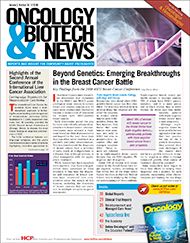Publication
Article
OBTN
Nanotech-based Methylation Testing May Profoundly Impact Cancer Diagnosis, Treatment Assessment
Author(s):
Researchers at the Johns Hopkins University School of Medicine in Baltimore, Maryland, have developed an innovative test to screen for chemical modifications to DNA, which are known as methylation. The test could potentially be used to diagnose cancer early on and to assess patients' response to cancer therapies.
Click here to view as PDF.
Academic research is fueling tremendous strides in oncology and biotechnology. The Academy delivers the latest news on biotech and oncology research, providing a link between the clinical world of cancer care and the university researchers who are pushing the envelope of knowledge and discovery.
The Johns Hopkins University School of Medicine
Researchers at the Johns Hopkins University School of Medicine in Baltimore, Maryland, have developed an innovative test to screen for chemical modifications to DNA, which are known as methylation. The Johns Hopkins investigators presented the technology and described the methods used to gauge the test’s effectiveness and accuracy at September’s Third AACR International Conference on Molecular Diagnostics in Cancer Therapeutic Development in Philadelphia, Pennsylvania. The test could potentially be used to diagnose cancer early on and to assess patients’ response to cancer therapies.
During methylation, healthy genes can be switched on or off, possibly triggering cancer without any changes to the underlying DNA sequence. The current methods for methylation screening have significant drawbacks, according to the study’s lead author, Vasudev Bailey, a biomedical engineering PhD candidate at Johns Hopkins. Methylation-specific polymerase chain reaction (PCR) copies specific DNA sequences millions of times within a few hours and may not be sensitive enough to detect small amounts of methylation; realtime PCR, which allows scientists to view increases in the amount of DNA as it is copied, must be run several times and can be expensive, Dr. Bailey explained.
The new test was designed to make PCR technology more sensitive and efficient. Bailey and colleagues assessed their technique by treating segments of DNA with the chemical compound sodium bisulfate. This automatically converted unmethylated cytosines (one of the bases of DNA) to uracils (one of the bases of RNA, which works with DNA to synthesize proteins) but left the methylated cytosines untouched. The scientists next used PCR with labeled primers to copy and label these DNA segments with the vitamin biotin. Lastly, they added quantum dots (molecules about a billionth of a meter in size that have electrical properties) to the samples, which had been coated with the protein streptavidin. With near-magnetic force, the biotin-coated methylated segments of DNA were attracted to the streptavidin coating on the quantum dots, highlighting and quantifying DNA methylation.
Results indicated that the new test was sensitive enough to detect methylated DNA in amounts as little as 15 picograms (the equivalent of 5 cells) in the presence of a 10,000-fold excess of unmethylated coding sequences. It demonstrated detection capability in as few as 8 PCR cycles. Bailey and colleagues saw results using minute samples (an average of 800 billionth/L per reaction, using >50x less sample and reagent than current methods) and a novel lab-on-chip system. This system allows simultaneous processing and analysis of multiple samples with minimal handing. Researchers have a provisional patent on the test.
In additional experiments, researchers used the technology to detect methylation for the gene ASC/TMS1, which promotes programmed cell death, in low concentrations of DNA from human sputum. This was accomplished with fewer steps and fewer PCR cycles than traditional methods. Scientists also used the test to quantify the amount of methylation reversal in bone marrow fluid samples taken from patients with myelodysplastic syndrome—a disorder in which bone marrow cells do not function normally—before and after they were medically treated.
Dr. Bailey said that the test allows scientists to detect methylation of multiple genes at the same time or to view methylated and unmethylated DNA at the same time. It also reveals the percentage of methylation at any given time.
“The impact of detecting DNA methylation is profound, as it has been demonstrated that a larger number of tumor suppressor genes become inactivated through DNA methylation than by mutations,” concluded Dr. Bailey. “Our method of methylation screening provides an easy, cost-effective and valuable tool for the early diagnosis of cancer, monitoring tumor behavior and measuring the response of tumors to targeted cancer therapies.”
